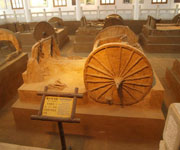Yin Xu is an ancient capital city that rose in the late Shang Dynasty, a time of prosperity of Chinese Bronze Age. Around the 17th century BC, the Shang tribe, an important branch of the Chinese nation, beat the Xia Dynasty and established a slave dynasty in central China, the second of its kind in Chinese history. The territory of this new dynasty extended to the great ocean in the east, the present-day Sichuan in the west, the Liaohe River Basin in the north, and the Dongtinghu Lake in the south. It was one of the most powerful states in the East Asia during the Bronze Age.

Continent: Asia
Country: China
Category: Cultural
Criterion: (II)(III) (IV) (VI)
Date of Inscription: 2006
Yin Xu Ancient History
In about 1300 BC, Pan Geng, the king of the Shang Dynasty, removed his capital from Yan to Yin Xu and built the latter into a magnificent capital city. Since then, this capital city continued being built by 12 kings in eight generations of the Shang Dynasty during 255 years. It remained the political, economic, military and cultural centre of China during the prime of its bronze age. Around the year 1046 BC, King Wu sent a punitive expedition against King Zhou, the last ruler of the Shang Dynasty. Yin was deserted and the city was turned into ruins, hence the name Yin Xu (the ruins of Yin) in historical sources.During the Qin and Han dynasties (221 B.C. to AD 23), references to Yin Xu were made frequently in history books. Epigraphy became popular during the Song and the Yuan Dynasties (AD 10th to 14th century). The frequent unearthing of bronzes around Xiaotun village aroused the attention of educated people. This city was then thought to be Xiang, the residence of the 12th king of the Shang Dynasty. In 1899, Wang Yirong, an epigrapher of the last years of the Qing Dynasty, discovered and proved that oracle bone inscription was the language used in the Shang Dynasty. After verification and exploration by many other scholars, Xiaotun of Anyang where oracle bone inscriptions were unearthed came to be established as the site of Yin Xu as recorded in Chinese classics.










No comments:
Post a Comment